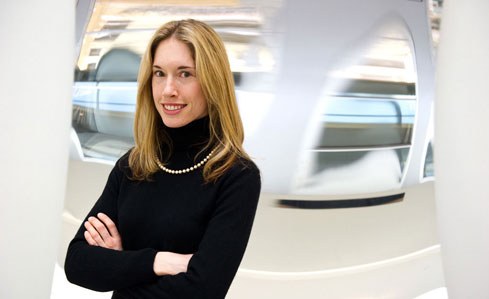
Ashley Finan: Developing better policy for energy innovation
When Ashley Finan receives her Ph.D. in Nuclear Science and Engineering (NSE), it won’t be so much the culmination of an academic career as a milestone in a journey begun a decade ago. Finan credits some unique opportunities at MIT with setting her on a path toward a “place where it’s possible to make the most positive impact” on clean energy solutions and climate change.
Finan, 27, entered MIT as an undergraduate in 2002 having “dreamt about going here since I was a little kid,” she says. She arrived with an interest in physics and its practical applications, and positively disposed to nuclear energy, having grown up a scant 10 miles from two Connecticut nuclear plants that seemed to her a good way to reduce dirty air emissions. “I felt strongly coal was doing a lot of damage…and that nuclear was a better source of energy.” Given her own aptitudes and interests, NSE and physics seemed a natural fit to her, and Finan leapt into Course 22.
From the beginning, she sought to balance classroom time with real-world experience, and she took every advantage of MIT’s undergraduate research program. She interned at Idaho National Laboratory, a hub for next-generation nuclear reactor research, collaborating with top-flight scientists from industry and other universities. Even while completing undergraduate requirements in reactor design and radiation, Finan engaged in challenging research ventures. A senior design project led to an internship for a firm attempting to pair nuclear energy technology with oil sands extraction in Canada; this became the basis of Finan’s master’s degree work. It was also a turning point for her studies. She learned “how oil companies and nuclear engineering companies really work,” and how “the biggest concerns were actually economic and political.” Finan returned to MIT “with a better understanding of the issues faced by the energy industry,” she says. “This helped crystallize my interest in policy.”
With this newly refined focus, Finan devised an ambitious dissertation subject, “Energy System Transformation: An Evaluation of Innovation Requirements and Policy Options,” guided by NSE Department Head Richard Lester. She has conducted some of her research as a participant in the Energy Innovation Project, housed in MIT’s Industrial Performance Center. “I have been helping develop a framework for policymakers to assess options for climate change, energy security and other energy issues, and to help identify and design better policies to encourage energy innovation,” says Finan.
Her work shows that innovation on a massive scale will be required to manage the transformation from a high-carbon to a low-carbon-intensity energy system, and that serious funding obstacles often prevent the most promising energy innovation enterprises from reaching fruition. “There’s a valley of death between R&D and building at scale,” says Finan. Nuclear plants are one egregious example: “We’re pretty confident that they can provide power affordably once they’re built, but getting anybody to put enough capital at risk to build them is difficult. The investment required for one nuclear plant is larger than the entire balance sheet of most electric power companies in the U.S.”
Finan’s research suggests the U.S. must find a way to encourage high risk investment in energy innovation, to make public funding less vulnerable to the swings of politics, and to create an environment friendlier to private investment. Typical today are technology “push” policies that introduce a particular energy innovation, but do not create the conditions for its long-term survival. Finan prefers market “pull” policies aimed at “creating a competitive product and a flourishing market for a new technology.”
But while current political reality discourages the kind of market-based incentives she recommends, Finan can imagine an energy innovation sector that eventually resembles the IT, pharmaceutical or biology industries. After MIT-based post-doctorate work, Finan hopes to find a position where she can help bring the U.S. energy system closer to this vision. “It’s going to be very hard to leave MIT, but I really want to get to work supporting energy innovation.”
"I have been helping develop a framework for policymakers to assess options for climate change, energy security and other energy issues, and to help identify and design better policies to encourage energy innovation."
Written by Leda Zimmerman
Photos by Justin Knight
